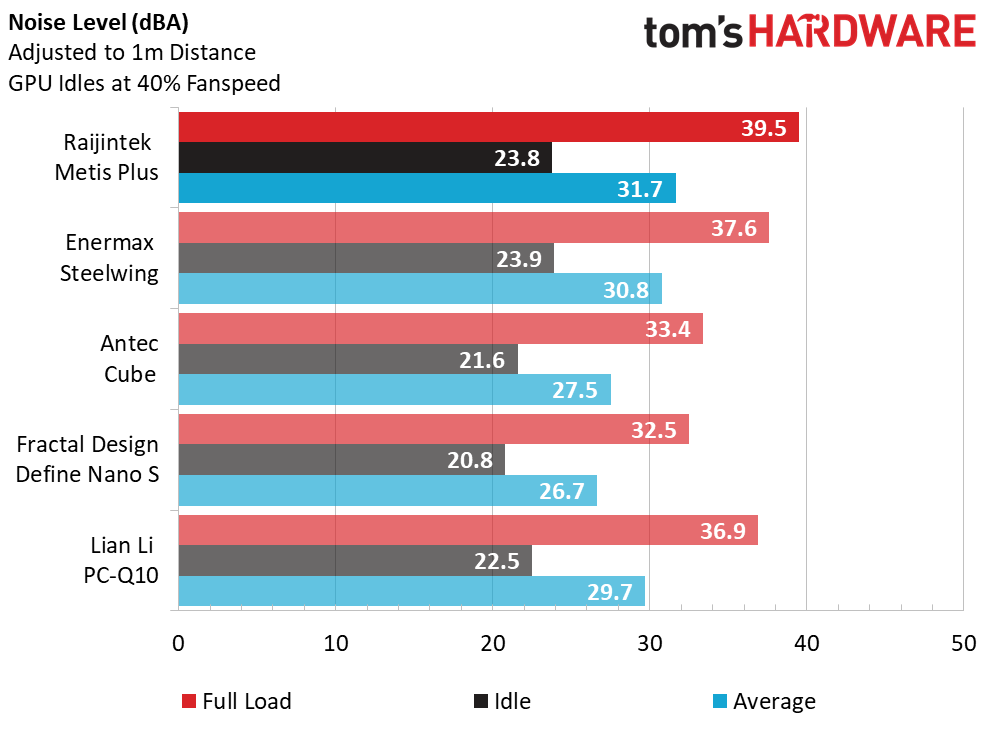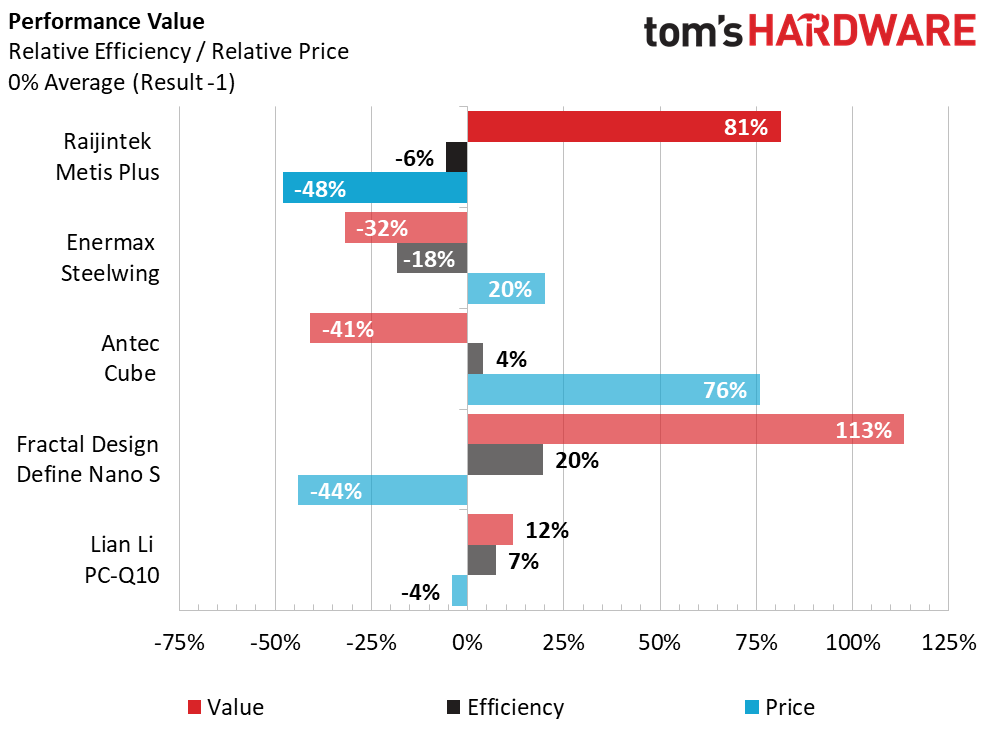Raijintek Metis Plus Mini ITX Case Review
Why you can trust Tom's Hardware
Benchmarks & Conclusion
The Metis Plus’ single exhaust fan along with its compact size put it at a bit of a disadvantage compared to some of the other larger or better equipped cases in our comparison. However, its well-placed top and side vents do allow it to regain some ground and even help it achieve the lowest GPU temperature of all the cases listed.
The same vent that keeps the GPU nice and cool also seems to do little in the way of noise reduction, making the Metis Plus the loudest case in today’s test.
Marginal temperature results coupled with poor noise results lead to overall poor performance in our efficiency benchmark.
Even with its inefficient performance, the Metis Plus price tag gives it a massive performance-per-dollar advantage over its more expensive rivals. Fractal Design’s Define Nano S only manages to maintain the lead due its combination stellar performance and low price.
Even though there’s the possibility of it being a bit noisy under some workloads, the Metis Plus is still an excellent value for its price. For $65 you’re getting a well made aluminum case that’s very compact and portable and yet is still capable of handling mid or even high-end gaming hardware. The Metis Plus has enough value and building potential to earn our seal of approval.
MORE: Best Cases
MORE: All Case Content
Get Tom's Hardware's best news and in-depth reviews, straight to your inbox.
-
2Be_or_Not2Be How tall of a CPU cooler can you mount in this case? I see a low-profile one was used for the review, and it would nice to know the actual limits for the cooler height.Reply -
Brian_R170 I build a computer for my son using one of these in May 2017 when they first showed up at a few US online retailers. One of the coolest things about this case is that it can be completely disassembled with screws, but since almost all of them thread into aluminum, you need to be careful. I totally agree that Raijintek should've kept the option for a vented aluminum side like the original Metis Classic (the Metis Classic panel still fits this case, BTW). They also should just skip the ATX PSU mounting and make it SFX only. It's feasible to get an ATX PSU in there with a short "ITX" graphics card, but it's difficult to do without straining connectors, and it's certainly not pretty. With an SFX PSU, you can also easily fit longer graphics cards than Raijintek specs indicate. I found that creating a duct between the top vent and graphics card fan made a small but significant difference in GPU temp and reversing the rear fan to be an intake made an even bigger difference in CPU temp. The build is super clean using an SFX PSU with short modular cables, and ITX-length graphics card, and only M.2 storage, but it can quickly get messy from there.Reply -
2Be_or_Not2Be Reply20634142 said:I found that creating a duct between the top vent and graphics card fan made a small but significant difference in GPU temp and reversing the rear fan to be an intake made an even bigger difference in CPU temp.
So where is hot air exhausting? If the top vent is a duct to your GPU as an intake, the rear is also pulling air in, then where is the hot air going? Is it all going out through the PSU? If so, seems like the PSU's longevity might be shortened. Plus, that seems like it would create hot spots as the hot air will rise (unless somehow the air being pushed out by the GPU's fans - if it's not a blower-style venting out - is somehow creating a flow of air going down).
I see holes on the side where the motherboard would lie; however, that seems really inefficient as it's covered by the m/b.
-
Brian_R170 Reply20634801 said:So where is hot air exhausting? If the top vent is a duct to your GPU as an intake, the rear is also pulling air in, then where is the hot air going? Is it all going out through the PSU? If so, seems like the PSU's longevity might be shortened. Plus, that seems like it would create hot spots as the hot air will rise (unless somehow the air being pushed out by the GPU's fans - if it's not a blower-style venting out - is somehow creating a flow of air going down).
I see holes on the side where the motherboard would lie; however, that seems really inefficient as it's covered by the m/b.
The air gets pushed out through several places, including the side panel, the small vent in back, the ATX-SFX PSU adapter plate, and of course the PSU itself. The graphics card also vents at least 1/3 of it's hot air through it's own PCI slot bracket. The Corsair SF450 PSU is semi-passive and we have yet to even see the PSU fan turn on outside of running a torture test right after assembly. This is with a 65W i7-7700 CPU and Gigabyte GTX1070 mini. -
2Be_or_Not2Be Reply20637600 said:20634801 said:So where is hot air exhausting? If the top vent is a duct to your GPU as an intake, the rear is also pulling air in, then where is the hot air going? Is it all going out through the PSU? If so, seems like the PSU's longevity might be shortened. Plus, that seems like it would create hot spots as the hot air will rise (unless somehow the air being pushed out by the GPU's fans - if it's not a blower-style venting out - is somehow creating a flow of air going down).
I see holes on the side where the motherboard would lie; however, that seems really inefficient as it's covered by the m/b.
The air gets pushed out through several places, including the side panel, the small vent in back, the ATX-SFX PSU adapter plate, and of course the PSU itself. The graphics card also vents at least 1/3 of it's hot air through it's own PCI slot bracket. The Corsair SF450 PSU is semi-passive and we have yet to even see the PSU fan turn on outside of running a torture test right after assembly. This is with a 65W i7-7700 CPU and Gigabyte GTX1070 mini.
So are you using the vented side panel from the Metis "Classic" instead of the new one with the non-vented acrylic window? If so, my guess is that the vented side panel is where the majority of the hot air is exhausting.
I also agree with making a SFX PSU standard for this case. Internal space always helps when you're building a smaller case. -
Brian_R170 Reply20638019 said:So are you using the vented side panel from the Metis "Classic" instead of the new one with the non-vented acrylic window? If so, my guess is that the vented side panel is where the majority of the hot air is exhausting.
I also agree with making a SFX PSU standard for this case. Internal space always helps when you're building a smaller case.
No, I'm talking about the vents on the motherboard side. There is about a 7mm gap between the motherboard and the motherboard tray, plus another 2mm or so between the tray and the side panel. It's more than enough space for the air that can exit through the side panel holes. I know the airflow isn't ideal (like pretty much any SFF case), but we played around with it and this configuration keeps the critical components measurably cooler. Of course, setting it on carpet is a no-no because the feet can sink into the carpet and that blocks the bottom ventilation which is around half of the total exhaust surface area.
-
2Be_or_Not2Be Reply20638751 said:No, I'm talking about the vents on the motherboard side. There is about a 7mm gap between the motherboard and the motherboard tray, plus another 2mm or so between the tray and the side panel. It's more than enough space for the air that can exit through the side panel holes. I know the airflow isn't ideal (like pretty much any SFF case), but we played around with it and this configuration keeps the critical components measurably cooler. Of course, setting it on carpet is a no-no because the feet can sink into the carpet and that blocks the bottom ventilation which is around half of the total exhaust surface area.
Interesting. Well, it sounds like if you make the rear fan an intake, then you definitely should be running a SFX PSU.
Thanks for the info! I'm always on the lookout for good-performing mini-ITX cases. My go-to for a while has been Silverstone cases - like the old classic SUGO series. However, they can be a bit lacking in style for some (I'm personally okay with a clean, minimalist look). A nicely colored case can add a splash of style, though. -
Valantar A great review, even if this isn't the case for me. On that note: any plans for a review of the NZXT H200i in the near future? Even though I'd prefer a "silent" version (sound dampening in the top/rear/front, possibly a solid side panel), it's the top contender for my planned ITX move. Need a case that can fit my 240+120mm rads, a res and my Fury X, so it needs to have some volume, but preferably not too much. The Define Nano S is nice, but a bit boring-looking.Reply -
Flying-Q Reply
From their website they claim any CPU cooler up to 160mm in height.20633966 said:How tall of a CPU cooler can you mount in this case? I see a low-profile one was used for the review, and it would nice to know the actual limits for the cooler height.
-
2Be_or_Not2Be Reply20643371 said:
From their website they claim any CPU cooler up to 160mm in height.20633966 said:How tall of a CPU cooler can you mount in this case? I see a low-profile one was used for the review, and it would nice to know the actual limits for the cooler height.
Thanks! I wish all reviewers would be required to include this info when they review mini-ITX cases as it's pretty critical for the smaller form factor.



